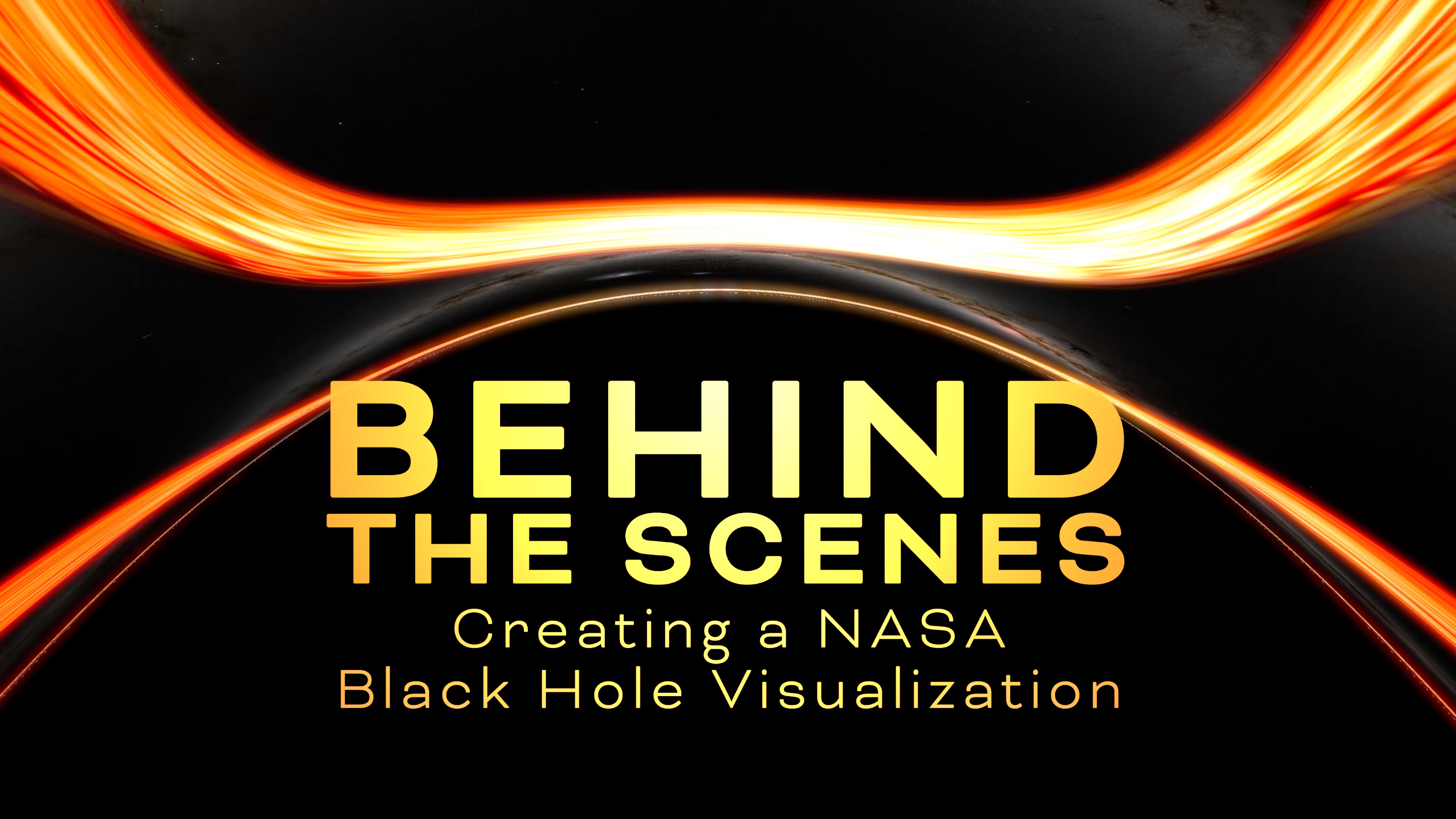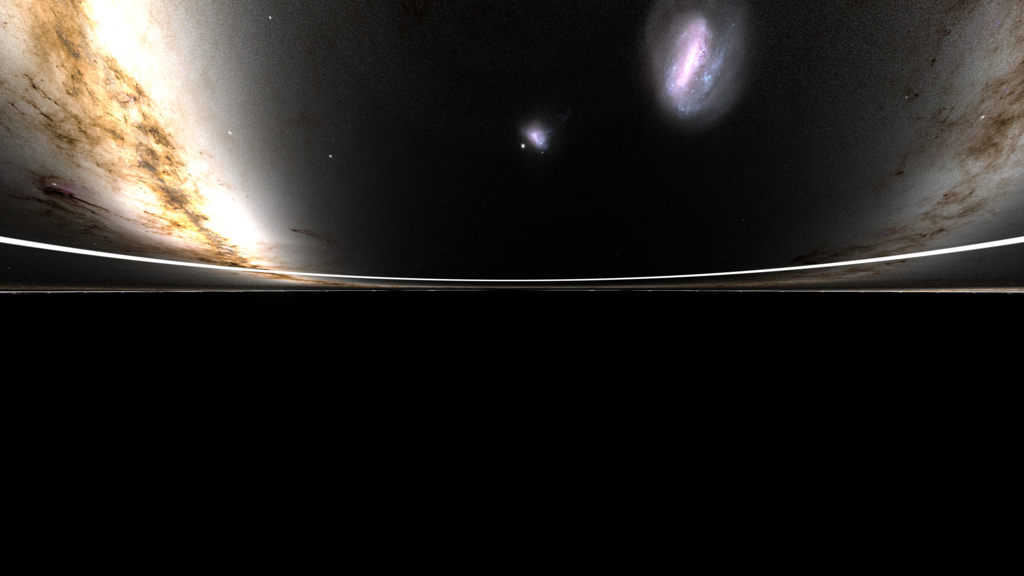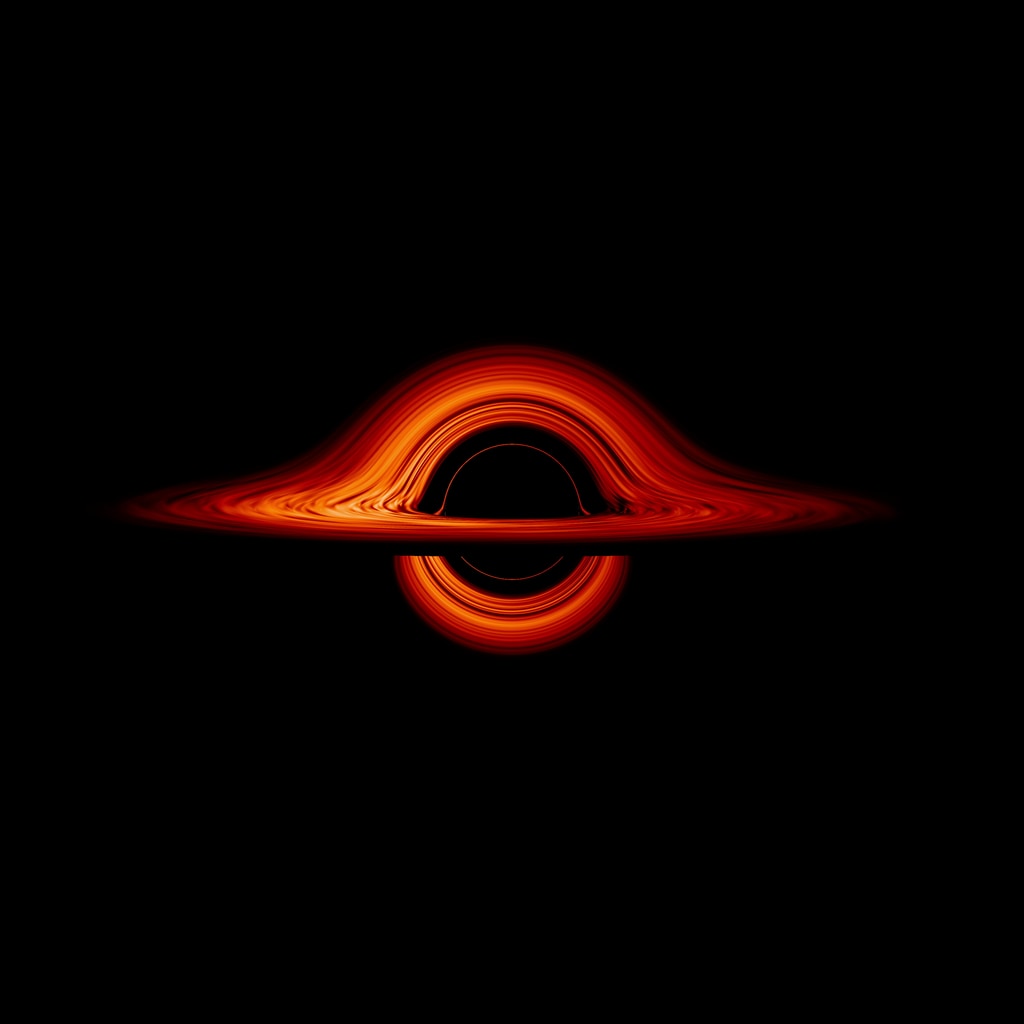NASA Black Hole Visualization Takes Viewers Beyond the Brink
In this flight toward a supermassive black hole, labels highlight many of the fascinating features produced by the effects of general relativity along the way. This supercomputer visualization tracks a camera as it approaches, briefly orbits, and then crosses the event horizon — the point of no return — of a supersized black hole similar in mass to the one at the center of our galaxy.
Credit: NASA's Goddard Space Flight Center/J. Schnittman and B. Powell
Music: “Tidal Force,” Thomas Daniel Bellingham [PRS], Universal Production Music
“Memories” from Digital Juice
“Path Finder,” Eric Jacobsen [TONO] and Lorenzo Castellarin [BMI], Universal Production Music
Watch this video on the NASA Goddard YouTube channel.
Complete transcript available.
New, immersive visualizations produced on a NASA supercomputer let anyone take a trip into a black hole’s point of no return.
The visualizations represent two scenarios, one where a camera — a stand-in for a daring astronaut — just misses the event horizon and slingshots back out, and another where the camera enters the event horizon, sealing its fate.
The visualizations are available in multiple forms, including 360-degree videos that let viewers look all around during the trip. Explainer videos act as sightseeing guides, highlighting the bizarre effects of Einstein’s general theory of relativity. Additional versions are rendered as flat all-sky maps.
Goddard scientists created the visualizations on the Discover supercomputer at the NASA Center for Climate Simulation.
The destination is a supermassive black hole with 4.3 million times the mass of our Sun, equivalent to the monster located at the center of our Milky Way galaxy. To simplify the complex calculations, the black hole is not rotating.
A flat, swirling cloud of hot, glowing gas called an accretion disk surrounds the black hole and serves as a visual reference during the fall. So do glowing structures called photon rings, which form closer to the black hole from light that has orbited it one or more times. A backdrop of the starry sky as seen from Earth completes the scene.
The project generated about 10 terabytes of data — equivalent to roughly half of the estimated text content in the Library of Congress — and took about 5 days running on just 0.3% of Discover’s 129,000 processors. The same feat would take more than a decade on a typical laptop.
Movies and frame sets are available below. For more detailed information using specific frames, see Beyond the Brink: Tracking a Simulated Plunge into a Black Hole. Some numbers to think about:
- The outer edge of the accretion disk extends to a radius of about 97 million miles (156 million kilometers), comparable to the distance between Earth and the Sun.
- The inner edge of the accretion disk starts at a radius of around 23 million miles (38 million kilometers), about 25% of the Earth-Sun distance.
- The radius of the photon ring is 15.5 million miles (25 million kilometers).
- The event horizon radius is about 7.8 million miles (12.5 million kilometers).
- Spaghettification occurs around 79,500 miles (128,000 kilometers) from the singularity, the center of the black hole.
This version is encoded to play as a 360 VR movie. It follows the plunge of a simulated camera into a non-rotating supermassive black hole. The object's mass is 4.3 million Suns, equivalent to the black hole lying at the center of our Milky Way galaxy. The orange structure surrounding the black hole represents the hot, glowing gas of its accretion disk, where infalling matter collects and slowly spirals inward. Interior to the disk is a thin set of photon rings, which are images of the disk produced by light that has orbited the black hole one or more times before reaching the camera. The camera completes almost two orbits before hitting the event horizon. During the journey, a variety of effects caused by the gravitationally warped space-time around the black hole and the camera's speed become increasingly apparent. Images of the disk and the background sky morph, duplicate, and even form mirror images. Structures in the direction of travel, at the center of the simulation, brighten greatly as speed increases. At 42 seconds, the camera crosses the event horizon, traveling ever closer to the speed of light. Due to the camera’s speed, the entire sky appears to shift progressively forward, shrinking before our eyes. After entering the event horizon, the camera would be destroyed by tidal forces 12.8 seconds later, then in microseconds rush to the singularity, a point in the black hole's center where the laws of physics as we know them no longer apply.
Credit: NASA's Goddard Space Flight Center/J. Schnittman and B. Powell
Music: “Tidal Force,” Thomas Daniel Bellingham [PRS], Universal Production Music
Watch this video on the NASA Goddard YouTube channel.
Complete transcript available.
Camera plunge, equidistant rectangular projection. This all-sky movie follows the plunge of a simulated camera into a non-rotating supermassive black hole. The object's mass is 4.3 million Suns, equivalent to the black hole lying at the center of our Milky Way galaxy. The orange structure surrounding the black hole represents the hot, glowing gas of its accretion disk, where infalling matter collects and slowly spirals inward. Interior to the disk is a thin set of photon rings, which are images of the disk produced by light that has orbited the black hole one or more times before reaching the camera. The camera completes almost two orbits before hitting the event horizon. During the journey, a variety of effects caused by the gravitationally warped space-time around the black hole and the camera's speed become increasingly apparent. Images of the disk and the background sky morph, duplicate, and even form mirror images. Structures in the direction of travel, at the center of the simulation, brighten greatly as speed increases. At 42 seconds, the camera crosses the event horizon, traveling ever closer to the speed of light. Due to the camera’s speed, the entire sky appears to shift progressively forward, shrinking before our eyes. After entering the event horizon, the camera would be destroyed by tidal forces 12.8 seconds later, then in microseconds rush to the singularity, a point in the black hole's center where the laws of physics as we know them no longer apply.
Credit: NASA's Goddard Space Flight Center/J. Schnittman and B. Powell
Camera plunge, Mollweide equal-area projection. This all-sky movie follows the plunge of a simulated camera into a non-rotating supermassive black hole. The object's mass is 4.3 million Suns, equivalent to the black hole lying at the center of our Milky Way galaxy. The orange structure surrounding the black hole represents the hot, glowing gas of its accretion disk, where infalling matter collects and slowly spirals inward. Interior to the disk is a thin set of photon rings, which are images of the disk produced by light that has orbited the black hole one or more times before reaching the camera. The camera completes almost two orbits before hitting the event horizon. During the journey, a variety of effects caused by the gravitationally warped space-time around the black hole and the camera's speed become increasingly apparent. Images of the disk and the background sky morph, duplicate, and even form mirror images. Structures in the direction of travel, at the center of the simulation, brighten greatly as speed increases. At 42 seconds, the camera crosses the event horizon, traveling ever closer to the speed of light. Due to the camera’s speed, the entire sky appears to shift progressively forward, shrinking before our eyes. After entering the event horizon, the camera would be destroyed by tidal forces 12.8 seconds later, then in microseconds rush to the singularity, a point in the black hole's center where the laws of physics as we know them no longer apply.
Credit: NASA's Goddard Space Flight Center/J. Schnittman and B. Powell
This sequence shows a zoom into the plunging camera’s direction of travel to reveal the detailed structure of the photon rings. Each band is a distorted image of the gas disk layered between the background sky. Successive bands are thinner, produced by photons that have taken an additional trip around the black hole before reaching the camera. Due to the camera’s speed, which approaches 99.9% that of light toward the end, the entire sky appears to shift progressively forward, seemingly shrinking before our eyes. The field of view is 10 degrees across, about the width of a fist held at arm’s length.
Credit: NASA's Goddard Space Flight Center/J. Schnittman and B. Powell
Plunge camera track. This movie tracks the position and orientation of the falling camera relative to the black hole. The inner circle represents the event horizon, the dashed circle represents the photon ring, which forms at the edge of the event horizon's shadow (twice the event horizon's size), and the dotted line shows the camera's path. A red line represents the plane of the accretion disk surrounding the black hole. At about 15 seconds, the image zooms in to follow the camera as it makes almost two loops around the black hole. At 42 seconds, the camera slips past the event horizon and arcs to the black hole's center.
Credit: NASA's Goddard Space Flight Center/J. Schnittman
Visual description: On a black background, a white cartoon camera approaches a broken red line interrupted by a large dashed white circle at its center. Inside the dashed circle is a smaller white circle with a solid line. The camera, trailing a dotted line as it travels, spirals into the central white circle.
Plunge clock comparison. This movie tracks the local time of the falling camera, the time as experienced by a faraway observer (coordinate time), and the maximum blueshift observed. This is the factor by which the frequency of light in the direction of travel is increased. At 42 seconds, coordinate time reads all 9s, indicating that the camera has crossed the event horizon and external time is infinite. The blueshift continues to climb, exceeding 43 by the end, which indicates motion exceeding 99.9% light speed.
Credit: NASA's Goddard Space Flight Center/J. Schnittman
Visual description: A box on a white background contains three lines of text. The top line reads "local time," the second line reads "coord time," and the third reads "max blueshift." As the video plays, these times increase and diverge as described above.
In this flight toward a supermassive black hole, labels highlight many of the fascinating features produced by the effects of general relativity along the way. This supercomputer visualization tracks a camera as it approaches, falls toward, briefly orbits, and escapes a supersized black hole similar in mass to the one at the center of our galaxy.
Credit: NASA's Goddard Space Flight Center/J. Schnittman and B. Powell
Music: "Beautiful Awesome,” David Husband and James William Banbury [PRS], Universal Production Music
“Awakening Yearning,” David Ashok Ramani and Jonathan Elias [ASCAP], Universal Production Music
“Dawning,” Lorenzo Castellarin [BMI], Universal Production Music
Watch this video on the NASA Goddard YouTube channel.
Complete transcript available.
This version is encoded to play as a 360 VR movie. It follows the trajectory of a simulated camera approaching and looping around a non-rotating supermassive black hole. The object's mass is 4.3 million Suns, equivalent to the black hole lying at the center of our Milky Way galaxy. The orange structure surrounding the black hole represents the hot, glowing gas of its accretion disk, where infalling matter collects and slowly spirals inward. Interior to the disk is a thin set of photon rings, which are images of the disk produced by light that has orbited the black hole one or more times before reaching the camera. The camera completes two orbits before escaping back out to safety. During the journey, a variety of effects caused by the gravitationally warped space-time around the black hole and the camera's speed become increasingly apparent. Images of the disk and the background sky morph, duplicate, and even form mirror images. Structures in the direction of travel, at the center of the simulation, brighten greatly as speed increases. At 46 seconds, the camera makes its closest approach to the event horizon, reaching maximum velocity at 60% the speed of light.
Credit: NASA's Goddard Space Flight Center/J. Schnittman and B. Powell
Music: "Beautiful Awesome,” David Husband and James William Banbury [PRS], Universal Production Music
Watch this video on the NASA Goddard YouTube channel.
Complete transcript available.
Camera flyby, equidistant rectangular projection. This all-sky movie follows the trajectory of a simulated camera approaching and orbiting a non-rotating supermassive black hole. The object's mass is 4.3 million Suns, equivalent to the black hole lying at the center of our Milky Way galaxy. The orange structure surrounding the black hole represents the hot, glowing gas of its accretion disk, where infalling matter collects and slowly spirals inward. Interior to the disk is a thin set of photon rings, which are images of the disk produced by light that has orbited the black hole one or more times before reaching the camera. The camera completes two orbits before escaping back out to safety. During the journey, a variety of effects caused by the gravitationally warped space-time around the black hole and the camera's speed become increasingly apparent. Images of the disk and the background sky morph, duplicate, and even form mirror images. Structures in the direction of travel, at the center of the simulation, brighten greatly as speed increases. At 46 seconds, the camera makes its closest approach to the event horizon, reaching maximum velocity at 60% the speed of light.
Credit: NASA's Goddard Space Flight Center/J. Schnittman and B. Powell
Camera flyby, Mollweide equal-area projection. This all-sky movie follows the trajectory of a simulated camera approaching and orbiting a non-rotating supermassive black hole. The object's mass is 4.3 million Suns, equivalent to the black hole lying at the center of our Milky Way galaxy. The orange structure surrounding the black hole represents the hot, glowing gas of its accretion disk, where infalling matter collects and slowly spirals inward. Interior to the disk is a thin set of photon rings, which are images of the disk produced by light that has orbited the black hole one or more times before reaching the camera. The camera completes two orbits before escaping back out to safety. During the journey, a variety of effects caused by the gravitationally warped space-time around the black hole and the camera's speed become increasingly apparent. Images of the disk and the background sky morph, duplicate, and even form mirror images. Structures in the direction of travel, at the center of the simulation, brighten greatly as speed increases. At 46 seconds, the camera makes its closest approach to the event horizon, reaching maximum velocity at 60% the speed of light.
Credit: NASA's Goddard Space Flight Center/J. Schnittman and B. Powell
This sequence shows a zoom into the camera’s direction of travel as it loops around the black hole to reveal the detailed structure of the photon rings. Each band is a distorted image of the gas disk layered between the background sky. Successive bands are thinner, produced by photons that have taken an additional trip around the black hole before reaching the camera. The field of view is 10 degrees across, about the width of a fist held at arm’s length.
Credit: NASA's Goddard Space Flight Center/J. Schnittman and B. Powell
Flyby camera track. This movie tracks the position and orientation of the falling camera relative to the black hole. The inner circle represents the event horizon, the dashed circle represents the photon ring, which forms at the edge of the event horizon's shadow (twice the event horizon's size), and At about 15 seconds, the image zooms in to follow the camera as it makes two loops around the black hole. At 46 seconds, the image zooms out as the camera escapes.
Credit: NASA's Goddard Space Flight Center/J. Schnittman
Visual description: On a black background, a white cartoon camera approaches a broken red line interrupted by a large dashed white circle at its center. Inside the dashed circle is a smaller white circle with a solid line. The camera, trailing a dotted line as it travels, loops twice around the dashed circle.
Flyby clock comparison. This movie tracks the local time of the falling camera, the time as experienced by a faraway observer (coordinate time), and the maximum blueshift observed. This is the factor by which the frequency of light in the direction of travel is increased. As the video plays, these times increase and diverge, and by the end, local time lags coordinate time by 36 minutes. At 46 seconds, the blueshift reaches 2.34 as the camera's motion peaks at 60% the speed of light.
Credit: NASA's Goddard Space Flight Center/J. Schnittman
Visual description: A box on a white background contains three lines of text. The top line reads "local time," the second line reads "coord time," and the third reads "max blueshift."
For More Information
See NASA.gov
Credits
Please give credit for this item to:
NASA's Goddard Space Flight Center. However, individual items should be credited as indicated above.
-
Producer
- Scott Wiessinger (KBR Wyle Services, LLC)
-
Science writer
- Francis Reddy (University of Maryland College Park)
-
Visualizer
- Jeremy Schnittman (NASA/GSFC)
-
Support
- Brian Powell (NASA/GSFC)
-
Ernie Wright
(USRA)
Series
This page can be found in the following series:Release date
This page was originally published on Monday, May 6, 2024.
This page was last updated on Tuesday, September 3, 2024 at 3:25 PM EDT.



